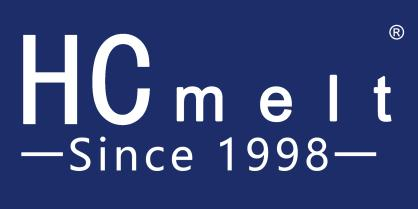

Hot melt adhesive (HMA), also commonly called “hot glue,” is a thermoplastic adhesive that is applied in a molten state and solidifies upon cooling. Its strength depends on many factors, such as formulation, temperature, substrate, and application method. This article explores how strong hot melt adhesives are, what affects their strength, where they perform well (and where they don’t), and how one supplier, HUACHUN, fits into the picture.
Polymer Base The backbone polymer has a large influence. Common bases include:
EVA (ethylene-vinyl acetate) – offers good bonding to many surfaces but limited heat and chemical resistance.
Polyolefins – better for non-polar surfaces, more elasticity in some formulations.
Polyamides – higher thermal resistance, better strength under elevated temperature, more durable under stress.
PUR / Reactive HMAs – these cure further (e.g. with moisture) after cooling and deliver enhanced strength in demanding conditions.
Additives & Formulation Details Strength is also influenced by:
Tackifiers (resins) – improve initial adhesion/tack and how well the adhesive wets the surfaces.
Waxes – these affect set speed (how fast it solidifies), viscosity, and flow. Too much wax can reduce strength; too little can make application harder.
Molecular weight, crystallinity, degree of polymer chain entanglement – these determine how much force the set adhesive can resist without deforming or breaking.
Temperature Effects
Application temperature: If too low, the molten adhesive won’t wet the surfaces well; too high, the polymer may degrade.
Service temperature: Once cured, hot melt adhesives will lose strength when exposed to temperatures above their softening point. Polyamide HMAs can sometimes resist up to ~200 °C in short-term applications.
Surface & Substrate Conditions
Cleanliness, surface energy, roughness: Contaminants like dust, grease, or very smooth, low-energy plastics can reduce adhesion.
Matching adhesive type to substrate polarity (polar vs non-polar) matters.
Mechanical Stress & Environment
Shear strength, peel strength, impact resistance are typical measures. Under shear (sliding) loads, or peel loads, performance can be quite different.
Exposure to moisture, chemicals, UV, and cyclic temperature changes can degrade bond strength over time. PUR-type and polyamide HMAs often perform better in adverse environments.
While the exact numbers vary by product and application, here are some typical ranges / comparative values:
| Test Type | Typical Strength Range or Example |
|---|---|
| Lap shear strength (on treated metal or plastic) | 1,200 – 1,500 psi for certain untreated polypropylene surfaces under good formulation & surface prep. |
| Higher strengths (flexible substrate or optimized formulation) | Up to ≈ 3,000 psi in some cases. |
| Service temperature (heat resistance) | EVA types may soften around 60-80 °C; polyamide types can handle ~200 °C for short periods. |
These numbers show that hot melts are capable of quite strong bonds, but strength depends heavily on matching adhesive formulation to the task.
Strengths:
Very fast setting upon cooling → rapid bond formation; useful in high-speed production lines.
Strong bond to many substrates (metal, wood, many plastics and textiles), particularly with proper formulation and surface prep.
Lower emissions compared to solvent-based adhesives; simpler handling in many settings.
Weaknesses / Limitations:
Heat sensitivity: at elevated temperatures the adhesive may soften, creep, or fail. Not ideal for very high-temperature or long-duration heat exposure unless using high-temperature/resistant adhesive types.
Chemical resistance: many hot melts are vulnerable to solvents or aggressive chemicals unless specially formulated.
Peel strength often less than shear strength; peel or impact loads can cause failure more easily.
Some substrates (very low-energy plastics, greasy or contaminated surfaces) are hard to bond well. Surface treatment may be needed.
To get the strongest possible bond from hot melt adhesive, consider:
Choosing an adhesive formulation suited for the substrate and environment (e.g. high heat, moisture, mechanical stress etc.)
Ensuring surfaces are clean, possibly roughened or treated to raise surface energy
Using proper application temperature and pressure; ensuring good wetting during application
Allowing proper cooling and avoiding excessive stress until adhesive fully solidifies
Considering reactive hot melts (e.g. moisture-cured) for enhanced durability and environmental resistance where needed
HUACHUN is a manufacturer & supplier of hot melt adhesives. Their product lines include:
Hot melt adhesive films
Granules, powders, webs etc.
For customers seeking performance-tailored adhesives, HUACHUN offers a range of formulations. If you need good strength under specific conditions (for example higher heat, flexible substrates, or special substrate types), HUACHUN likely has options that can meet those requirements. Their variety of product forms (film, granules, powder, web) allows more flexibility in processing and matching adhesive delivery method to your manufacturing process.
In summary, hot melt adhesives can be very strong—depending on polymer type, formulation, substrate, temperature, and application technique, they are capable of shear strengths in the thousands of psi and good performance over a range of conditions. However, they are not universally ideal: heat, chemicals, peel/impact loads, or low-energy surfaces can pose challenges. If you need high bond strength in demanding applications, reactive or high-temperature types such as polyamide or PUR formulations are better choices.
Previous: How Hot Does Adhesive Melt?